It had been a windy night, and dust and sand had been flying all around the campsite. In fact the campsite was a depressing sight, just a flat dustbowl with the occasional tree adding a splash of shade, no grass whatsoever. The Bonati campsite at Flagstaff had no grass neither, just black volcanic cinders, but it had more trees, had more room, and was undulating, which added that little bit of vitality. However, what this campsite in Big Pine lacked in grass, it made up for in toilets and showers; they were immaculate.
I wanted an early start, so I forwent my usual culinary practice, and nipped into Big Pine for breakfast. The cafe was standard, and a steady stream of old guys sauntered in, greeted other old codgers who were seated at the counter, sat themselves at the counter and ordered coffee. This seemed a standard procedure for old boys, the coffee bar was their meeting place.
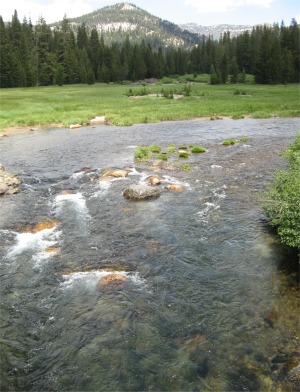
San Joaquin River Flowing Through Lush Meadows
|
Once fed, I drove up the 395 to Mammoth Lakes, calling in at the visitor centre on the way. According to the park ranger, campsites were likely to be full since it was a popular place and it was also the weekend. He did show me where dispersed camping was allowed though. With that established, I drove straight up to the Mammoth Mountain Ski Area Main Lodge, as far as I was allowed to drive. After that I would need to take a shuttle bus to progress any further, similar to the Zion Canyon access mode.
My main objective for the day was to visit the Devils Postpile. I took the shuttle bus up to the Ranger Station, from where I would walk to the Postpile. The driver gave a running commentary on the way, pointing out how the trees were changing as we changed elevation. One tree was the Red Fir tree, also known as the Widowmaker. It got this reputation because the tree rotted from the inside, and without warning would come crashing down. As the tree rotted, its core would break down into small shapes resembling monopoly houses. Another snippet of information concerned the Aspen tree, "The largest living organism there is", he said. The root systems all joined together forming a large living group of trees. I took his word for it.
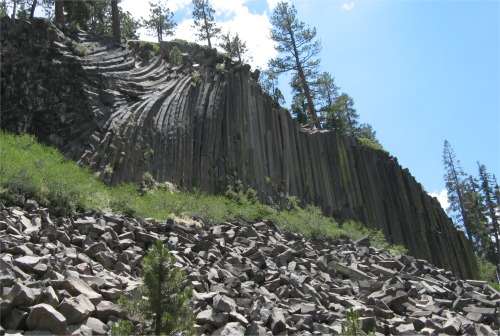
Devils Postpile
|
Soon we arrived at the Ranger Station, where I alighted and took a lovely walk by the San Joaquin River. Initially the river ran through lush meadows, but these were soon replaced by a rocky canyon. Within half a mile I had reached the base of the Postpile.
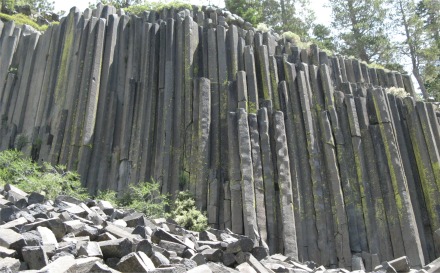
Close-up of the Postpile
|
The Devils Postpile was a dark cliff of columnar basalt near Mammoth Mountain in extreme northeastern Madera County in eastern California. The postpile was created by a lava flow sometime between less than 100,000 years ago (according to current potassium-argon dating) to 700,000 years ago (according to other dating methods). The source of the lava was thought to have been somewhere near Upper Soda Springs campground at the north end of Pumice Flat on the floor of the Middle Fork of the San Joaquin River, from where it flowed to the site of the Postpile. It was impounded by a moraine, and reached a thickness of 400', and the lava that now made up the Postpile was near the bottom of this mass.
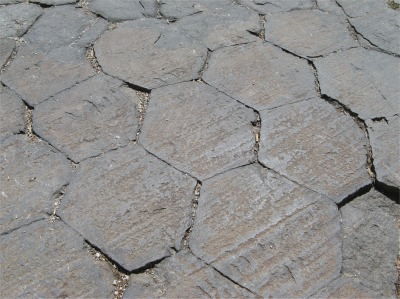
Glacier Ground Top of Postpile
|
Because of its great thickness, much of the mass of pooled lava cooled slowly and evenly, which was why the columns were so long and symmetrical. Columnar jointing occurred when certain types of lava cool; the joints developed when the lava contracted during the cooling process.
A glacier later removed much of this mass of rock and left a nicely polished surface on top of the Postpile with very noticeable glacial striations and glacial polish. The Postpile's columns averaged 2' in diameter, the largest being 3.5', and many were up to 60' long. Together they looked like tall posts stacked in a pile, hence the feature's name. If the lava had cooled perfectly evenly, all of the columns would be expected to be hexagonal, but some of the columns had different polygonal cross-sections on account of variations in cooling.
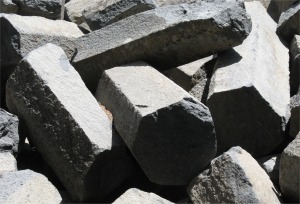
Broken Postpiles
|
Devils Postpile was once part of Yosemite National Park, but discovery of gold near Mammoth Lakes prompted a boundary change that left the Postpile on adjacent public land. A proposal to build a hydroelectric dam later called for blasting the Postpile into the river. Influential Californians, including Walter L. Huber, persuaded the federal government to stop the demolition and in 1911, President William Howard Taft made the area into a United States National Monument. The John Muir Trail and Pacific Crest Trail passed through the monument.
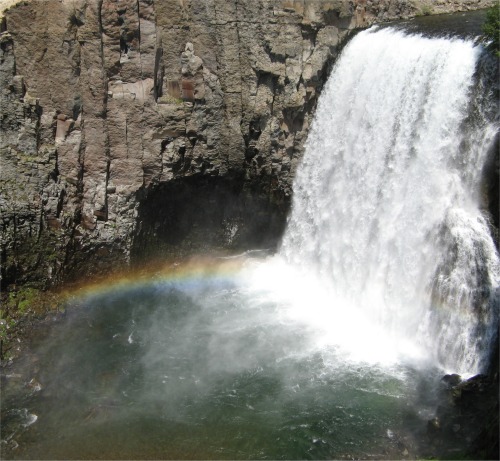
Rainbow Falls
|
It was amazing to see something like the Giant's Causeway in cross section. The size of it was staggering, and the sheer beauty of nature's symmetry was a pleasure to behold. I, like many others, just stood and admired. A display board gave a description of how the columns were created. A mum marched her daughter up to the board, and she read aloud every word, at machine gun pace, to the little girl. I thought how could the little girl possibly take it all in. I turned to the little girl, and pointed at the hexagon shape, and asked her if she knew of anything else that had that shape. A quizzical look crossed her face, then I made a buzzing noise. Her face lit up, she had realised that bees also make their honeycombs in hexagonal patterns. Then I hinted at white fluffy things falling out of the sky in winter. She soon latched on; she had seen magnified images of snowflakes. The mum seemed to take an interest, and I explained to her that hexagons take up less room than other shapes and tend to be more energy efficient. That might have gone over her head, but hopefully she had seen a different approach to educating her child.
I walked round a loop to bring me to the top of the pile, and here the hexagons were very pronounced, and indeed they had been scraped and polished by a glacier in times gone by. I was pleased I had made the effort to come and see this geological wonder. A couple I met later told me that there was something similar up in Washington state.
I moved on from the Postpile, and headed for Rainbow Falls, a short hike from the Postpile. The trail hugged the river, seamlessly passing from the John Muir Wilderness to the Ansel Adams Wilderness. An appreciable portion of the trail went through an area that was devastated by fire in 1996, caused by a lightening strike. The roar of the falls could be heard long before I saw them. The San Joaquin River plunged 101' over a lava ledge into a deep gorge. Due to the constant mist, a rainbow shone down in the gorge.
I walked down to the river at the base of the falls, and just enjoyed for a few minutes being bathed in the cool, refreshing spray from the falls. I followed this up with bathing my feet in the river whilst chewing jerky and trail mix. In the hot sun, this was exceedingly pleasant. But, there was a hint of a thunderstorm on the hills, so I decided to head to Reds Meadow to catch a shuttle bus back.
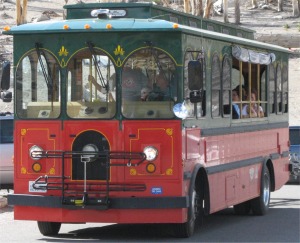
Transport Between the Lakes
|
Whilst on this walk to the bus stop, I overtook two women doing their utmost to encourage four small children to, "Keep going, it isn't far now". I could see their dilemma, the poor kids were tired and were ambling along at a snail's pace. I jollied the kids along, challenging them to races, and with a lot of cajoling, we all eventually reached the bus stop. It was every man for himself when it came to getting on the bus and grabbing a seat. A lot of folk were standing. Three of the children I had met sat in a seat across the aisle from me, so one of the mum's sat beside me. I found that they were all heading up from Los Angeles to a ranch further north, and had called in at the Postpile to break the journey. However, the kids wanted to see the waterfalls too, so for them it had turned out into a massive hike. No wonder they were tired, but they were good kids.
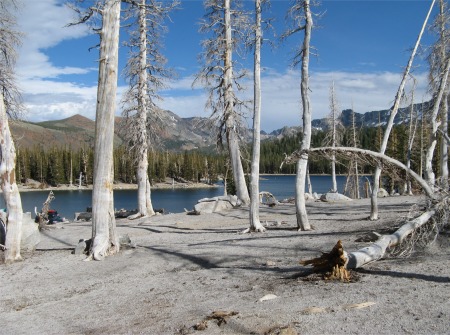
Horseshoe Lake
|
After my hikes, I drove down to Mammoth Lakes themselves. There were many lakes in the area, and some I could actually drive to. I didn't have any time left in the day to hike around the lakes. The lakes were set like jewels in a forested area nestling between lofty peaks. They were simply stunning, all with their own unique character, and all offering water sports and fishing. Campsites were scattered around the lakes, and I did drive around a few on the off chance that there might be a space. There wasn't, and in a way I was glad; these campsites just crammed folk in and they were virtually camping on top of each other. I'd stick to dispersed camping rather than have that.
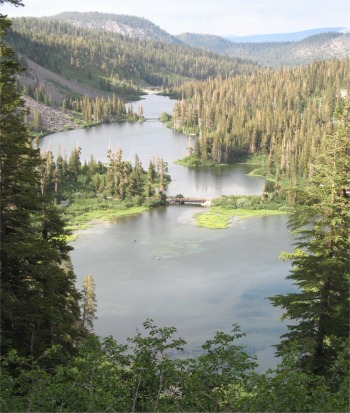
Twin Lakes
|
The whole area was geared up to recreation. The Mammoth Lakes village provided the hub with shops, eating establishments, motels and hotels for those not wishing to camp. Then out in the "wilderness" there was ample room to hike, bike, swim, fish, canoe, climb, horse ride, and in winter, ski. It was a place I would love to have spent a week at, but I knew I needed to move on.
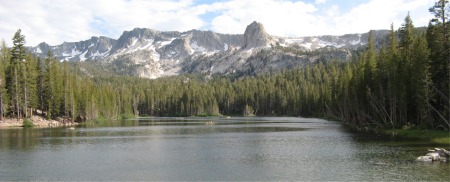
Lake Mamie
|
I drove some miles south east of Mammoth Lakes into another sagebrush wilderness within Owens Valley, and located a place to park up for the night near some Alkali Lakes. These were fenced off, with signs posted by the Los Angeles Water and Power Department warning people not to trespass. However, car loads of young folk were turning up to do their evening swims in the lakes.
I opened a beer and chilled out thinking what a lovely day it had been, and what a gem of an area it was. It reminded me very much of where I grew up, the English Lake District.

Lake Mary
|











